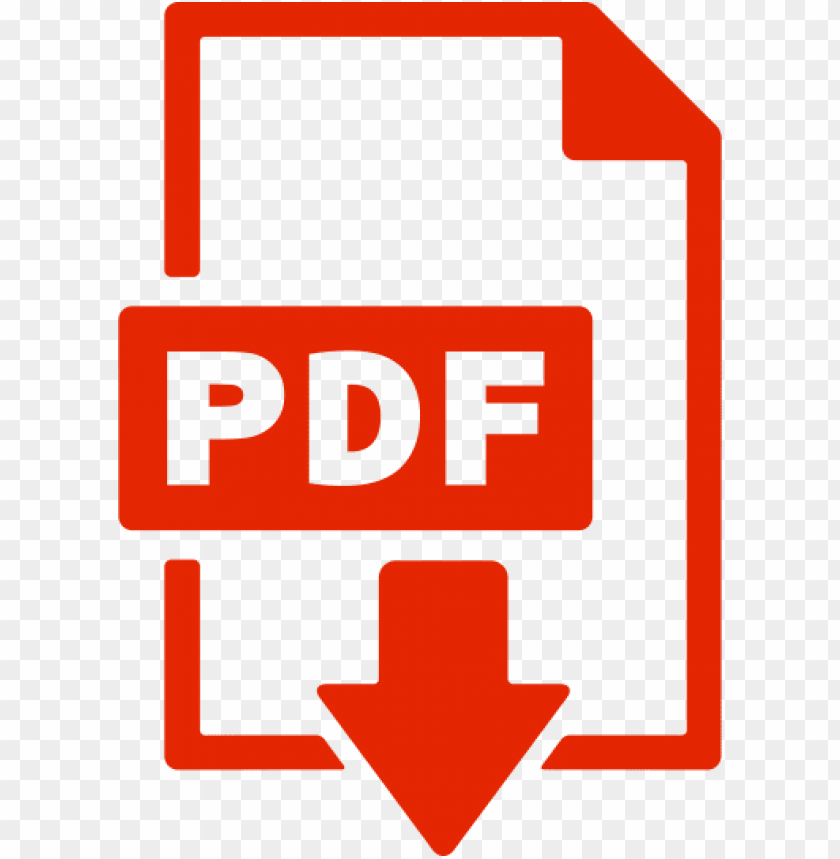July/August 2023
General Announcements
- Summary Report of the IUGG 28th General Assembly
- Peter Teunissen elected Fellow of the IUGG
- IAG Resolutions
- Correction to the 1999 IAG Resolution No. 3 on the calculation of group refractive index for EDM
Meeting Announcements
- Summer School on the Use of New Quantum Technologies in Geodesy
Meetings Calendar
IAG Sponsored Meetings
- GGOS Days 2023
- WGAAL2023
- ILRS Technical Workshop 2023
- 20th WEGENER Assembly 2023
- International School on the Geoid
- IVS 13th General Meeting and 25th Anniversary
Geodesy Related Meetings
- International Symposium on Satellite Navigation: Advances, Opportunities and Challenges (ISSN2023)
- AGU Fall Meeting
- EGU General Assembly 2024
- ION Pacific PNT Conference
- FIG Working Week 2024
- 45th COSPAR Scientific Assembly
General Announcements
Summary Report of the IUGG 28th General Assembly
Six geodesy-only symposia and seven joint, geodesy-lead symposia were organised with a total of 661 abstracts submitted.
- G01 Reference Systems and Frames. Convener(s): Christopher Kotsakis (Greece), Geoff Blewitt (USA), Johannes Boehm (Austria), Xavier Collilieux (France), Susanne Glaser (Germany)
- G02 Static Gravity Field and Height Systems. Convener(s): Laura Sanchez (Germany), Hussein Abd-Elmotaal (Egypt), Roland Pail (Germany), Elmas Sinem Ince (Germany)
- G03 Time-variable Gravity Field. Convener(s): Adrian Jäggi (Switzerland), Srinivas Bettadpur (USA), Frank Flechtner (Germany), Shuanggen Jin (China)
- G04 Earth Rotation and Geodynamics. Convener(s): Janusz Bogusz (Poland), Chengli Huang (China), Severine Rosat (France), Michael Schindelegger (Germany)
- G05 Multi-signal positioning, Remote Sensing and Applications. Convener(s): Allison Kealy (Australia), Zaminpardaz Safoora (Australia), Wielgosz Pawel (Poland), Beata Milanowska (Poland)
- G06 Monitoring and Understanding the Dynamic Earth with Geodetic Observations. Convener(s): Basara Miyahara (Japan), Detlef Angermann (Germany), Allison Craddock (USA), Hansjörg Kutterer (Germany)
- JG01 Interactions of the Solid Earth With Ice Sheets and Sea Level (IAG, IACS, IASPEI). Convener(s): Rebekka Steffen (Sweden, IAG), Bert Wouters (Netherlands, IACS), Natalya Gomez (Canada, IAG/IACS), Lambert Caron (US, IAG), Doug Wiens (US, IASPEI)
- JG02 Theory and Methods of Potential Fields (IAG, IAGA). Convener(s): Dimitrios Tsoulis (Greece, IAG), Sten Claessens (Australia, IAG), Maurizio Fedi (Italy, IAGA)
- JG03 Remote Sensing and Modelling of the Atmosphere (IAG, IAGA, IAMAS, IAVCEI). Convener(s): Michael Schmidt (Germany, IAG), Ehsan Forootan (Denmark, IAG), Loren Chang (Taiwan, China, IAGA), Claudia Stubenrauch (France, IAMAS), Fabio Dioguardi (Italy, IAVCEI)
- JG04 Satellite Gravimetry for Groundwater Monitoring (IAG, IAHS). Convener(s): Adrian Jäggi (Switzerland, IAG), Andreas Güntner (Germany, IAG), Felipe de Barros (Brazil/USA, IAHS), Michelle Newcomer (USA, IAHS)
- JG05 Geodesy for Climate Research (IAG, IAMAS, IACS, IAPSO, IAHS) Convener(s): Annette Eicker (Germany, IAG), Bert Wouters (Netherlands, IACS), John T Reager (USA, IAHS), Adam Scaife (UK, IAMAS), Benoit Meyssignac (France, IAPSO)
- JG06 Monitoring Sea Level Changes by Satellite and In-Situ Measurements (IAG, IAPSO). Convener(s): Xiaoli Deng (Australia, IAG), Steve Nerem (USA, IAG), Fabio Raicich (Italy, IAPSO)
- JG07 Modern Gravimetric Techniques for Geosciences (IAG, IAVCEI, IAPSO, IASPEI). Convener(s): Jürgen Müller (Germany, IAG), Chris Hughes (UK, IAPSO), Rudolf Widmer-Schnidrig (Germany, IASPEI), Emily Montgomery-Brown (USA, IAVCEI)
A summary of the Symposia reports given by the conveners at the IAG Closing Ceremonies can be found here.
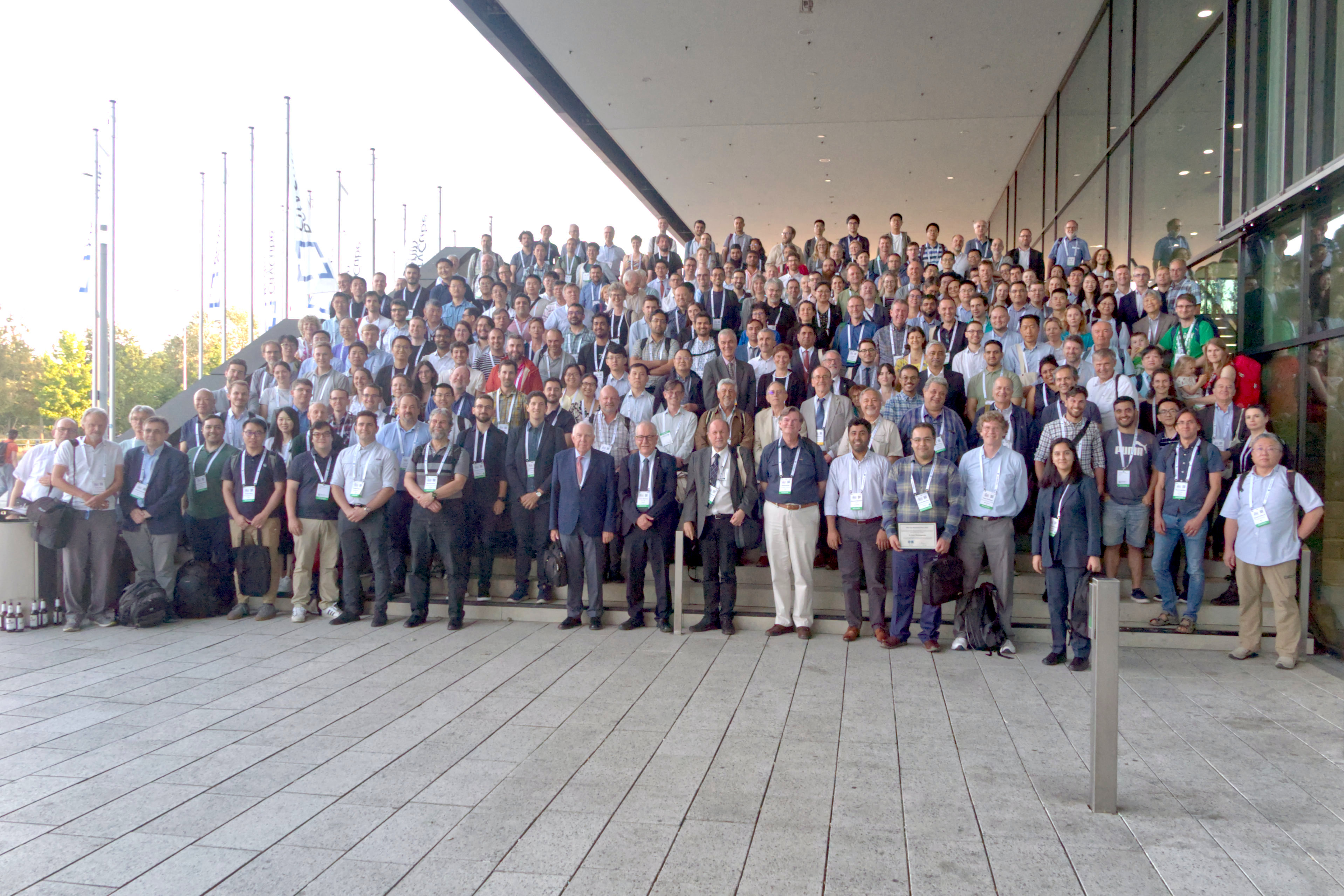 Group photo of the IAG participants
Group photo of the IAG participants
Council Meetings
The IAG Council had two meetings during the Assembly, July 12 and July 19. In the meeting of July 12, Secretary General introduced the budget for the last period 2019-2022, and the budget plan for the next period 2023-2026. The 2019-2022 budget showed a considerable surplus due to the Pandemic. Almost all activities were suspended for more than two years without any meetings or travel Award applications. The 2023-2026 budget is planned to have a large deficit to approach the balance in the long term budgeting. The council appointed the Audit Committee for examining the finances of the IAG and the planned budget. The members of the Audit Committee were Mattia Crespi, Italy, Chair), Xiaoli Deng (Australia), Ismael Foroughi (Canada), and Jyri Näränen (Finland).
The Council also appointed the Resolution Committee to prepare the IAG Resolutions. Members of the Committee were Christopher Kotsakis (President of Commission 1), Adrian Jäggi (President of Commission 2, Chair), Janusz Bogusz (President of Commission 3), Allison Kealy (President of Commission 4), and Basara Miyahara (President of GGOS).
Harald Schuh, Chair of the Cassinis Committee to prepare the changes in the IAG Statutes and bylaws introduced the proposed changes.
In the second meeting of the Council on July 19, the Audit Committee proposed in its report the discharge of the management and adoption of the budget which were approved unanimously. Also, the changes in the Statutes and the bylaws, as well as the resolution were approved. They can be found here.
Awards and Fellowships
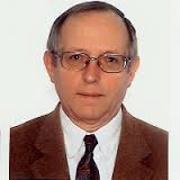
Georges Balmino
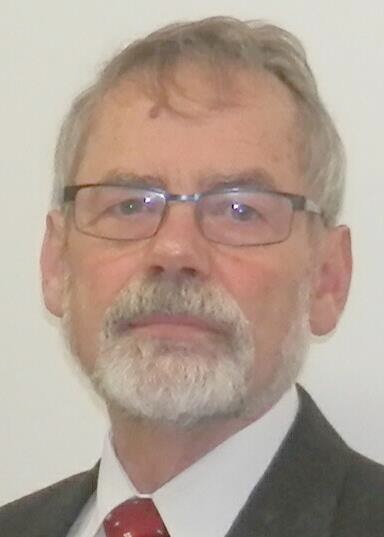
Hermann Drewes
IAG Awarded two Levallois medals which were awarded in recognition of distinguished service to the Association and the science of geodesy in general. The medals were awarded to Hermann Drewes for his invaluable impact on the development of the SIRGAS as well as for his more than 25-year-long duties within the IAG as Section Chair, Commission Chair and Secretary General (2007-2019), and Georges Balmino for his outstanding works on the modelling of the gravity fields of Earth, Moon and other planets as well as his key role in the planning phase of the dedicated Earth's gravity field satellite mission GOCE. Laudations, given by Harald Schuh and Gerhard Beutler can be found here and here, respectively.
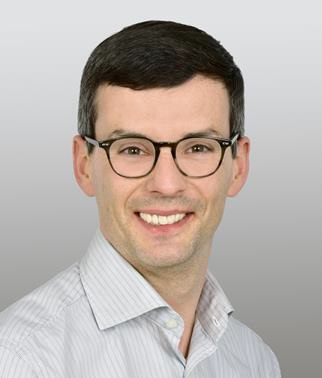
Matthias Willen

Radoslaw Zajdel
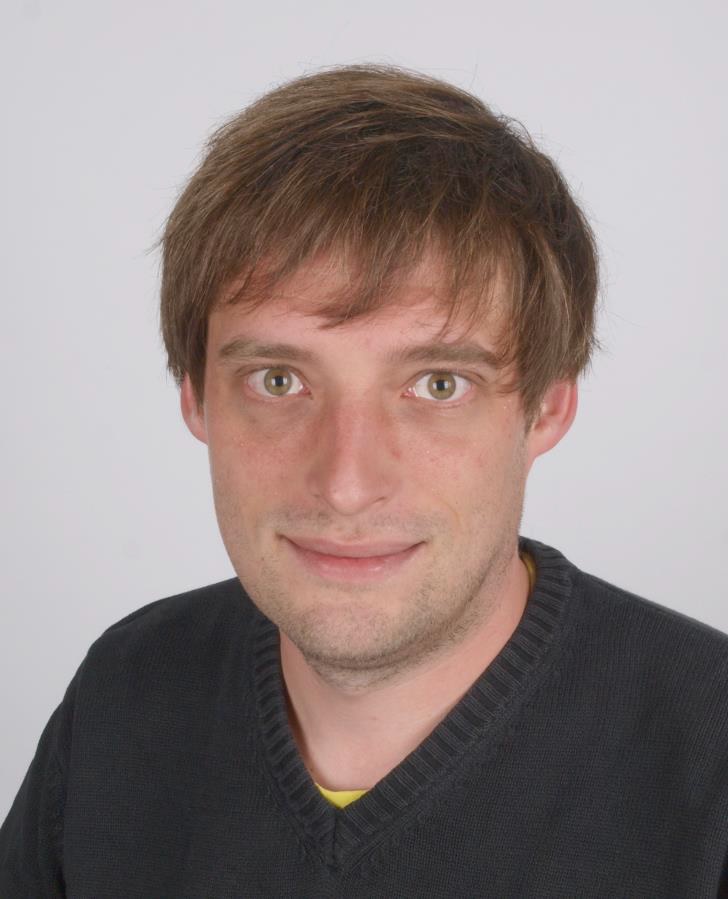
Jan Martin Brockmann
IAG established the Best Reviewer Award to officially recognize the important work of excellent reviewing for the Journal of Geodesy. The first one was awarded to Jan Martin Brockmann for reviewing extremely challenging manuscripts, including methodological papers with numerous development of ideas as well as for his careful and thorough and most importantly timely reviews.
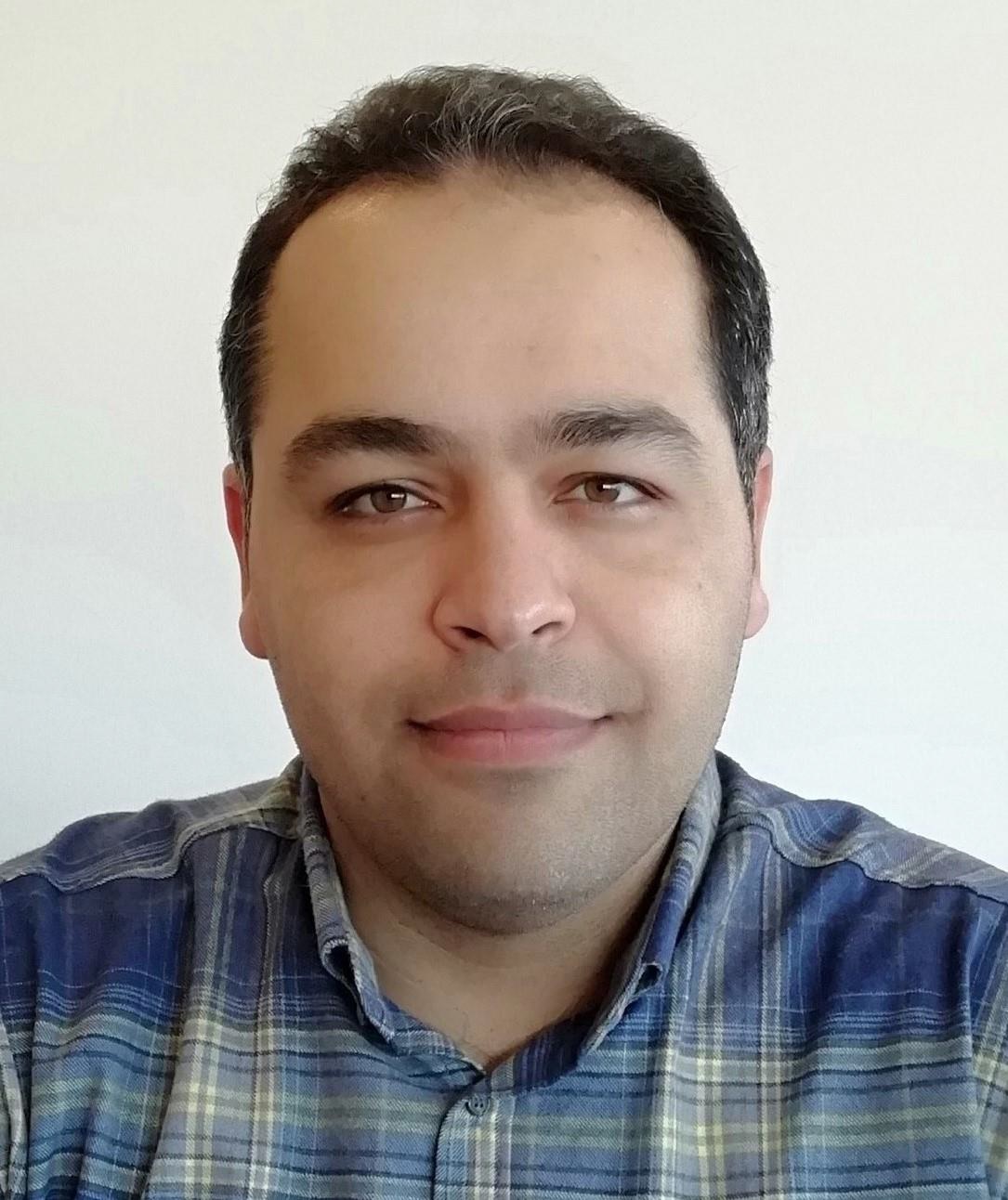
Amir Khodabandeh
A total of 23 new IAG Fellows were nominated and the certificates were given in the IAG Closing Ceremonies. New IAG Fellows are:
- Graham Appleby (UK)
- Kyriakos Balidakis (Germany)
- Elmar Brockmann ( (Switzerland))
- Sonia Costa (Brazil)
- Yamin Dang (China)
- Wei Feng (China)
- Gabriel do Nascimento Guimarães (Brazil)
- Ryan Hippenstiel (USA)
- Xiaopeng Li (USA)
- Martin Lidberg (Sweden)
- Ulrich Meyer (Switzerland)
- Basara Miyahara (Japan)
- Emily Montgomery-Brown (USA)
- Takuya Nishimura (Japan)
- Jean-Mathieu Nocquet (France)
- Toshimichi Otsubo (Japan)
- Paul Rebischung (France)
- Laura Ruotsalainen (Finland)
- Alvaro Santamaría-Gómez (France)
- Zheng-Kang Shen (USA)
- Wenbin Shen (China)
- Rebekka Steffen (Sweden)
- Derek van Westrum (USA)
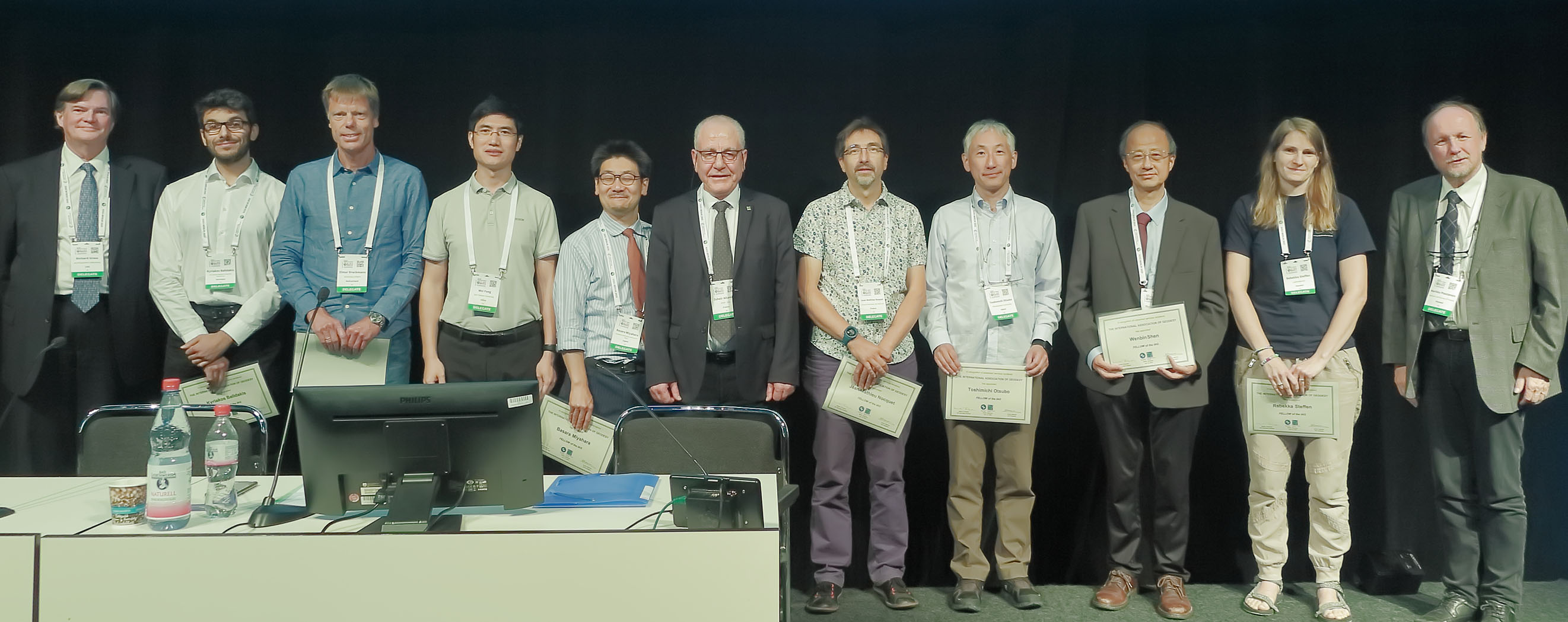
The new IAG Fellows present at the IAG Closing Ceremony
IAG President Zuheir Altamimi and Secretary General Markku Poutanen in the period 2019-2023 were promoted to the IAG Honorary President and Honorary Secretary General.
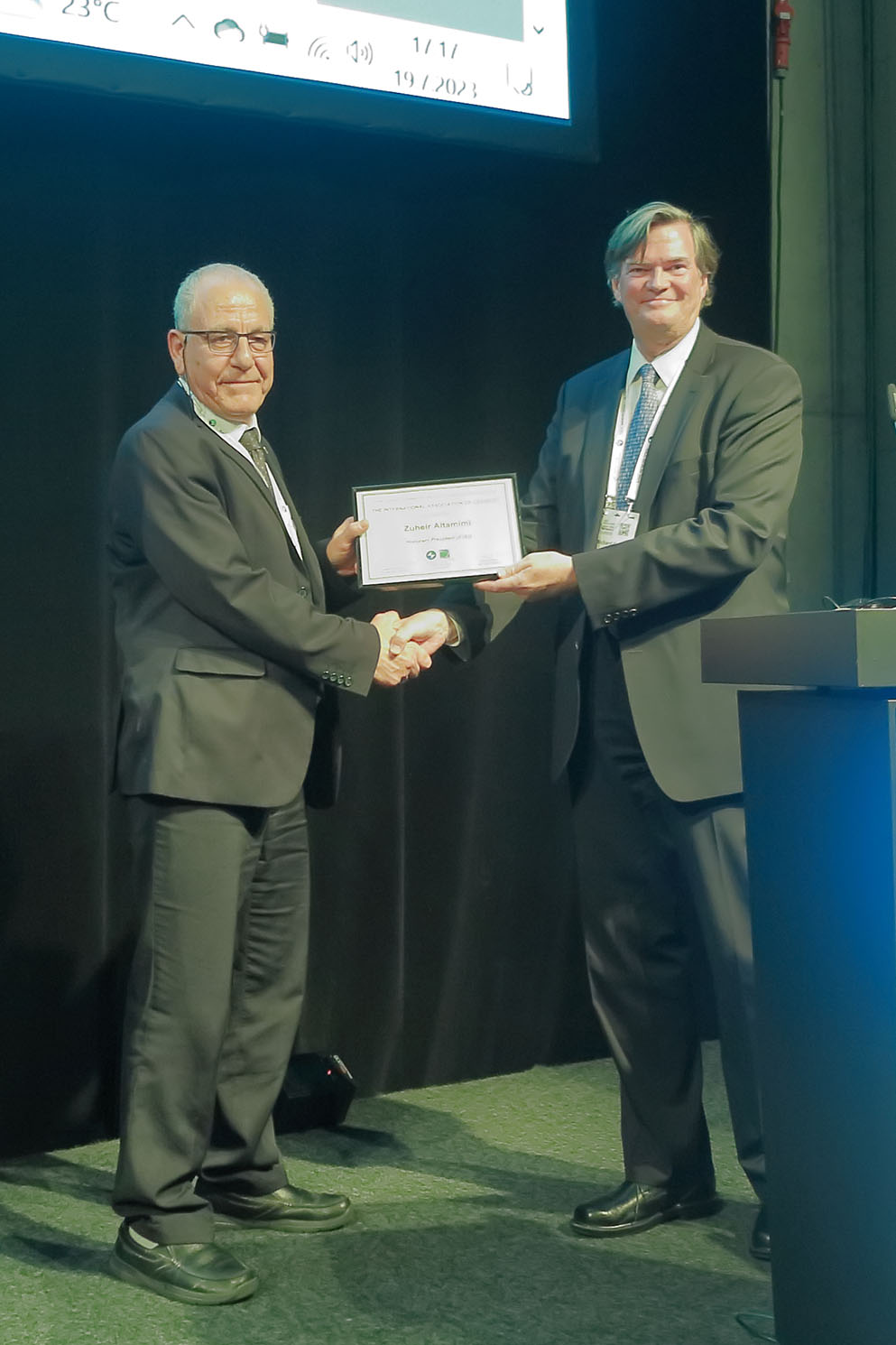
Zuheir Altamimi being promoted to
the IAG Honorary President
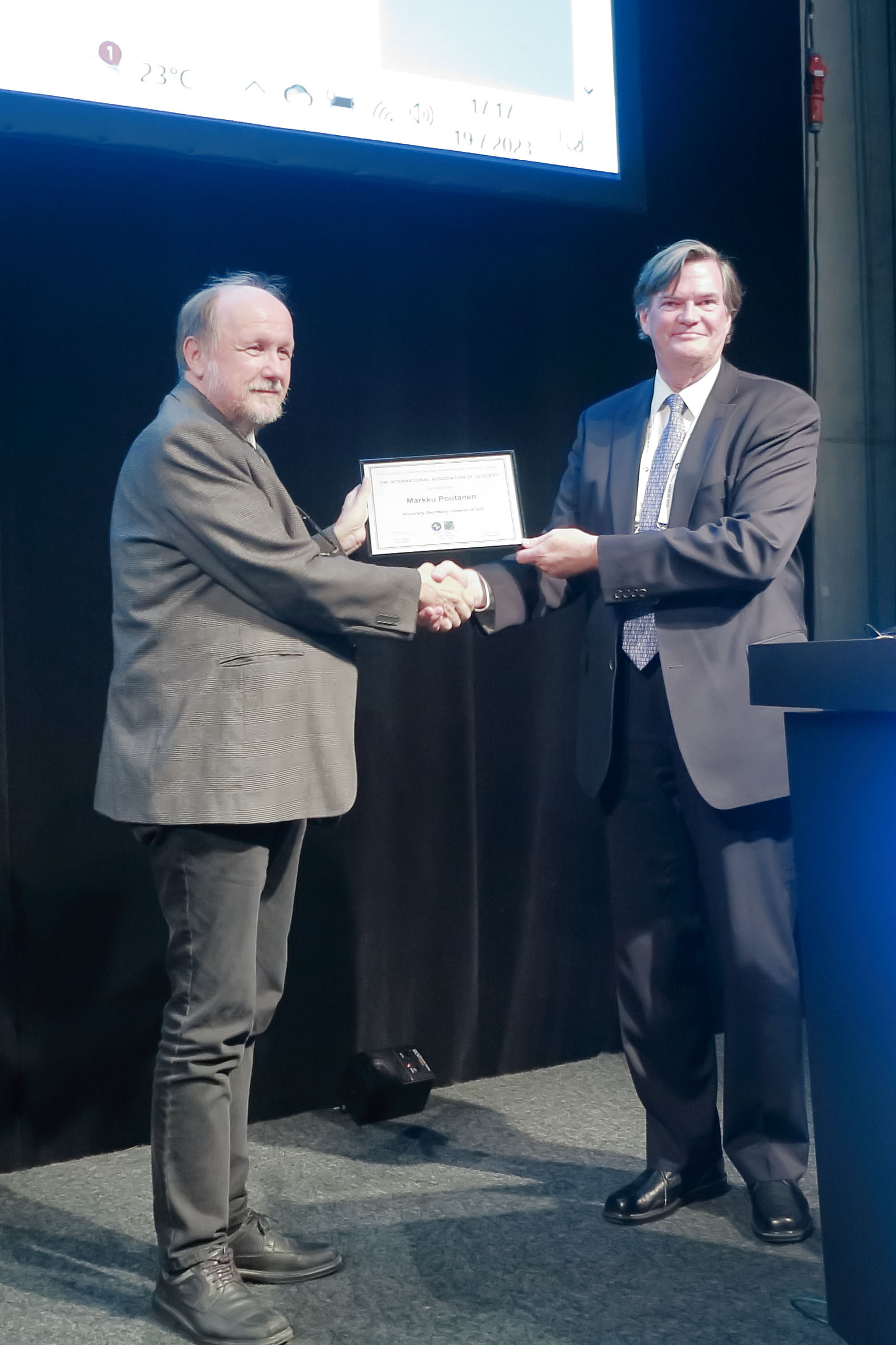
Markku Poutanen being promoted to
the IAG Honorary Secretary General
New Executive Committee
The IAG Council has elected the officers of the Association for the period 2023-2027. The members of the Executive Committee are:
- Richard Gross (president)
- Peter .J. Teunissen (vice-president)
- Daniela Thaller (secretary general)
- Zuheir Altamimi (immediate past president)
- Markku Poutanen (immediate past secretary general)
- Urs Hugentobler (president of Commission 1)
- Srinivas Bettadpur (president of Commission 2)
- Rebekka Steffen (president of Commission 3)
- Pawel Wielgosz (president of Commission 4)
- Mattia Crespi (president of Intercommission Committee on Theory)
- Anette Eicker (president of Intercommission Committee on Geodesy for Climate Research)
- Velérie Ballu (president of Intercommission Committee on Marine Geodesy)
- Szabolcs Rózsa (president of the Communication and Outreach Branch)
- Jürgen Müller (chair of the IAG Project Novel Sensors and Quantum Technology for Geodesy
- Maria Virginia Mackern (Member at Large)
- Masato Furuya (Member at Large)
- Laura Sánchez (president of the IAG Global Geodetic Observing System)
- Vincenza Luceri (Service Representative)
- Thomas Herring (Service Representative)
- Riccardo Barzaghi (Service Representative)
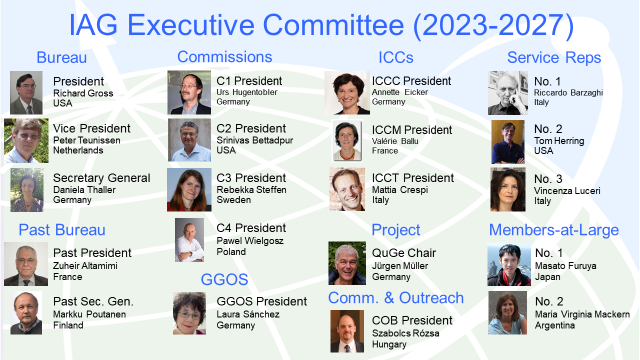
The new IAG Executive Committee held its first meeting in Berlin on July 20.
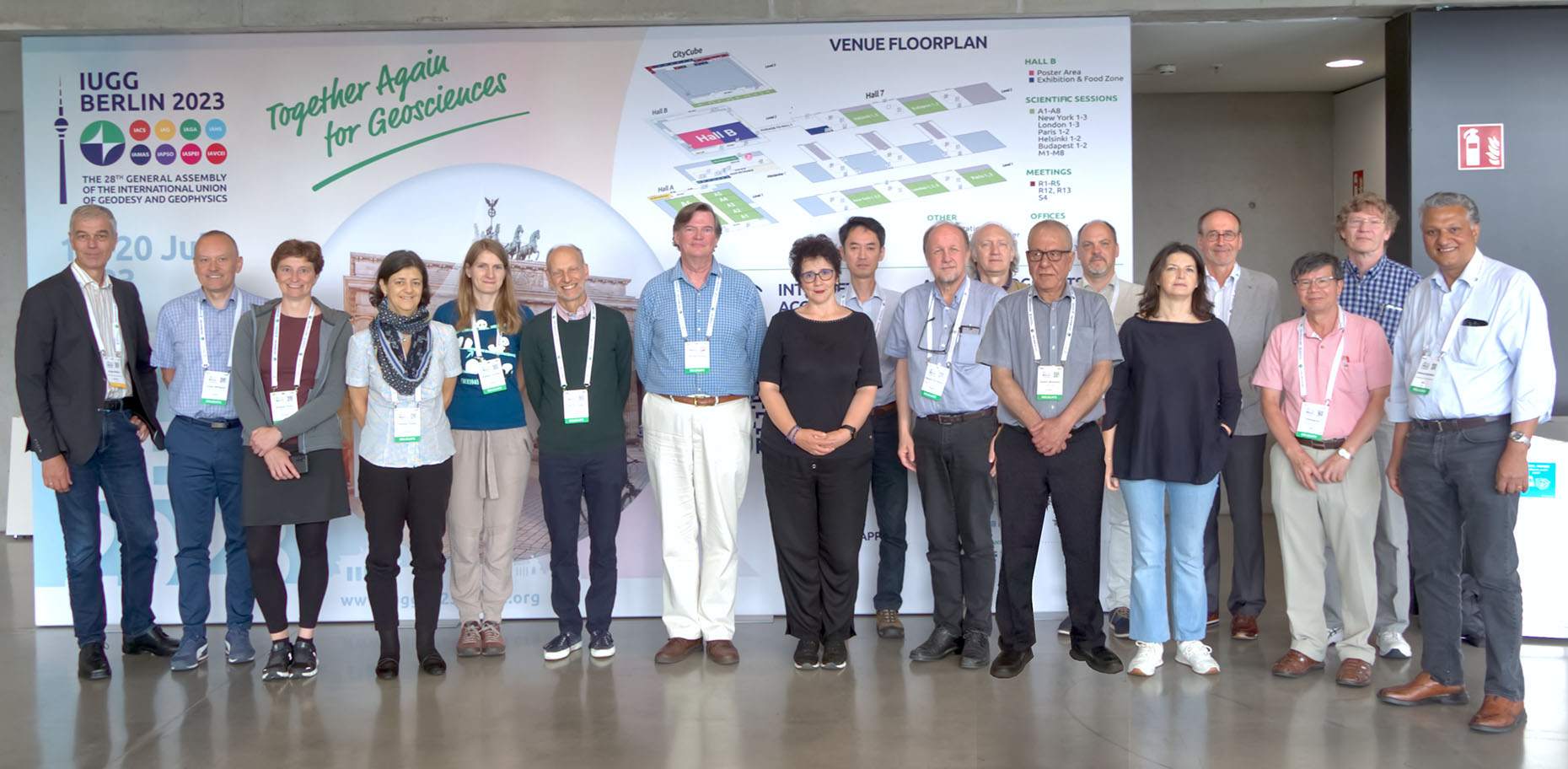
The Executive Committee (2023-2027) after its 1st meeting in Berlin
Reports and Upcoming events
IAG Reports (Travaux de l’IAG) vol 43 (2023) is in the IAG web site (https://www.iag-aig.org/travaux/Travaux2023). It has almost 1000 pages and contains detailed information on the activities of IAG entities in the period 2019-2022.
National reports are placed on the website as they are sent to the Secretary-General (https://www.iag-aig.org/national-reports/NatRep2023). We urge nations to submit the reports for the website.
Authors of IAG-related presentations (orals or posters) in the Assembly are urged to submit papers to the IAG Symposia Series. The submission deadline will be September 30 and the submission is via the Springer portal at http://www.springer.com/series/1345. There is a full peer review process and the accepted papers will be all open access. IAG is paying the fees, so the papers are free of charge to the authors. The page limit for a paper is 8 pages. Individual papers are available openly and citable on the Springer website shortly after acceptance. All papers from each volume will be packaged together as an open-access e-book once all editorial work is done.
The IAG Scientific Assembly 2025 will be held at Rimini, Italy, September 1-5. The event is hosted by the University of Bologna. Please, mark this already now in your calendar.
Markku Poutanen
Peter Teunissen elected Fellow of the IUGG
Professor Teunissen of Delft University of Technology, the Netherlands, was elected Fellow and Honorary Member of the IUGG ‘for his exceptional contributions and international leadership in the geodetic sciences, satellite positioning and navigation’. He received his award at the opening of the IUGG General Assembly 2023 in Berlin from IUGG’s Vice-President Prof. Chris Rizos.
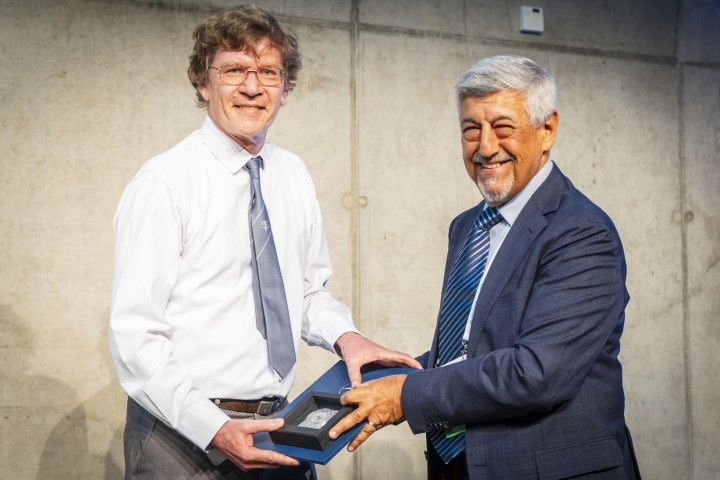
IAG Resolutions
Resolutions of the IAG are available from the IAG website at https://www.iag-aig.org/doc/64c67b2f61534.pdf.
Correction to the 1999 IAG resolution No. 3 on the calculation of group refractive index for EDM
IAG Resolution 3 of the 1999 Birmingham IUGG General Assembly recommended to compute the group refractive index in air for electronic distance measurement to better than one part per million (ppm) with visible and near infrared waves in the atmosphere using the computer procedure published by Ciddor & Hill in Applied Optics (1999, Vol.38, No.9,1663-1667) and Ciddor in Applied Optics (1996, Vol. 35, No.9, 1566-1573).
However, within the 18SIB01 GeoMetre project of the European Metrology Programme for Innovation and Research (EMPIR) in 2020 Florian Pollinger of PTB, Braunschweig, Germany pointed out that in the annex which provides the algorithm, there is a sign error which cause a deviation in results. The resulting group index of refraction deviates in about the correct order of magnitude from the group index but the deviation has the wrong sign. Explanation is published in: Pollinger, F. (2020) Refractive index of air. 2. Group index: comment Appl. Opt., OSA, 2020, 59, 9771-9772 https://doi.org/10.1364/AO.400796.
IAG recommends to use the correction published by Pollinger (2020) when using the Ciddor and Hill Formula according to the IAG Resolution #3 of 1999.
Meeting Announcements
Summer School on the Use of New Quantum Technologies for Geodesy
September 25-29 2023, Hannover, Germany
The Collaborative Reasearch Center TerraQ invites up to 30 M.Sc. and PhD students, to attend the 1st TerraQ Summer School on Modern techniques for gravity field recovery hosted at Leibniz University Hannover. The lectures, delivered by experts in the fields of Gravity Field Recovery, Relativistic Geodesy Terrestrial Gravimetry and Applications and Future Missions, aim at preparing the next generation of young researchers in these fields.
Accommodation as well as participation is free of charge for the selected attendees.
Registration Deadline is the 4th of August, 2023.
www.terraq.uni-hannover.de/de/summerschool23
Prof. Dr.-Ing. habil. Jürgen Müller
Meetings Calendar
IAG Sponsored Meetings
- GGOS Days 2023, September 20–22, 2023, Yebes, Spain
URL: https://ggos.org/event/ggos-days-2023/ - WGAAL 2023, October 16– 20, 2023, Lanzarote Island, Spain
URL: https://wgaal2023.csic.es/ - ILRS Technical Workshop, October 16-20, 2023, Virtual
URL: https://ilrs.gsfc.nasa.gov/about/meetings.html - 20th WEGENER Assembly 2023, October 24-27, 2023, Sousse, Tunisia
URL: https://congress-onm.tn/ - International School on the Geoid, November 15-17, 2023, Buenos Aires, Argentina
URL: https://sirgas.ipgh.org/escuela-geoide/en/home-2/ - IVS 13th General Meeting and 25th Anniversary, March 4-8, 2024, Tsukuba, Japan
URL: https://www.youtube.com/watch?v=mQkA8VHKWD4
Geodesy Related Meetings
- International Symposium on Satellite Navigation: Advances, Opportunities and Challenges (ISSN2023), November 20-22, 2023, Jiaozuo, Henan,China
URL: http://218.196.240.235/SatelliteNavigation-ISSN2023 - AGU Fall Meeting, December 11-15, 2023, San Francisco, CA, USA
URL: https://www.agu.org/Fall-Meeting - EGU General Assembly 2024, April 14 – 19, 2024, Vienna, Austria
URL: https://www.egu24.eu/ - ION Pacific PNT Conference, April 15-18, 2024, Honolulu, Hawaii
URL: https://www.ion.org/pnt/index.cfm - FIG Working Week, May 19-24, 2024, Accra, Ghana
URL:https://www.fig.net/fig2024/index.htm - 45th COSPAR Scientific Assembly, July 13-21, 2024, Busan, Korea
URL: https://www.cospar2024.org/ - 32th IAU General Assembly, August 6-15, 2024, Cape Town, South Africa
URL: https://astronomy2024.org/
Book Review
Geodesy (5th edition)
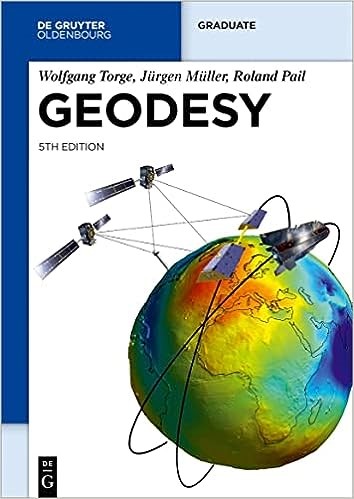
Title: Geodesy, 5th edition
Authors: Torge, Wolfgang, Müller, Jürgen and Pail, Roland
Publisher: De Gruyter Oldenbourg
ISBN: 9783110723298 (Paper), 9783110723304 (eBook)
Year: 2023
Price: € 69.95 (Paper), € 69.95 (PDF and eBook)
Details: 506 pages
Other: https://doi.org/10.1515/9783110723304
My five books of “Torge: Geodesy” are in front of me. The first two are still in German, and the 3rd, 4th and 5th editions are in English. The first edition from 1972 is a Göschen volume. Mine has disintegrated into its individual parts, obviously used a lot. This little volume is aimed at students of surveying and geodesy in the higher semester and at geoscientists in related fields. The small textbook conveys geodesy in an easily understandable form. It successfully combines the measurement methods with the underlying theoretical principles and evaluation methods as well as with the resulting products. It was possible to span the arc from the historical origins to the current applications in science and practice. It is noteworthy that this description still largely applies to the 5th edition now available. The concept and many parts of the text, illustrations, and formulas have made it from the first Göschen volume to the latest edition.
In the 50 years since it was first published, science and technology have made incredible advances. Geodesy, as "measuring and numerical science" benefited very fundamentally from these innovations when we think of electronics, automation, computers, data processing, and especially satellites and their possibilities. No other geodesy book described this development as complete and accurate. Think of the role of high-precision clocks, the method of time measurement, or satellite altimetry, which suddenly made it possible to measure the surface of the sea, the grandiose range of applications of "geodetic" GPS, now extended by several other global satellite positioning systems, SAR interferometry or satellite gravimetry. All these developments, each accompanied by a brief but very precise treatment of the theoretical basics and the description of the resulting new areas of application, can be followed wonderfully from the five editions of this classic; a journey through time worth reading.
The authors of the 5th edition of the textbook "Geodesy" are Wolfgang Torge, Jürgen Müller, and Roland Pail (after Jürgen Müller, who was added in the 4th edition, Roland Pail now completes the team of authors). The publisher is De Gruyter/Oldenbourg. The volume grew from 433 to 506 pages. The attractive exterior is similar to that of the 4th edition.
So what's new in the 5th edition? The basic structure, divided into 8 sections, was retained. A new chapter, “Geodesy: Challenges and Future Perspectives”, was added. All parts have been thoroughly revised, updated, and shortened in parts in order not to increase its volume significantly. Most of the many text inserts with historical or otherwise interesting additions have also been preserved. A probably unique treasure trove is the revised and expanded bibliography, with over 1000 entries. Here, too, the arc is drawn from the early years of geodesy to the present. The new edition also benefits from the addition of a large number of superb colour graphics which not only aid in understanding but also enhance the volume's aesthetics. Let me give a selection of newly added topics. The Global Geodetic Observing System (GGOS), as a synthesis and anchor point of the geodetic work on the geometry of the earth figure, the gravitational field, and the earth's rotation is explained, as well as the task of the related Subcommittee Geodesy under the umbrella of the United Nations. The emerging role of optical clocks as a future means of determining and unifying continental and intercontinental heights. The principle and the emerging role of quantum gravimetry. The latest developments in satellite altimetry applied to our planet's sea and ice surfaces and the focus on ice sheet melting and sea level rise. The detailed treatment of satellite gravimetry, i.e. the first gravity gradiometry mission GOCE and satellite-to-satellite tracking of GRACE, GRACE-FO, and possibly of future missions. This part includes the rationale of these methods and the processing of the mission data into gravity field models, whether as pure satellite models or as combination models with terrestrial gravity and topography data. After 50 years of development, accompanied by an increase in accuracy of three orders of magnitude and continuous refinement of the complete arsenal of terrestrial and satellite measurement methods, it can be claimed today: Geodesy is able to reliably reveal the tiny temporal changes of the earth’s figures, gravity field and rotation. An achievement of fundamental importance for geodesy itself and of inestimable value for hydrology, glaciology, oceanography, meteorology, and geodynamics. It is geodesy's contribution to research into the earth system and climate change. Almost somewhat hidden, this success story is highlighted in the eighth chapter with some outstanding examples. This part particularly benefits from the excellent colour graphics and is supplemented by many current references. As the authors write, the newly added ninth and final chapter is an attempt to place the contribution of geodesy that is achieved now in the context of global earth observation, and this against the background of the great social and scientific challenges. In my opinion, it is a successful step to classify the emerging developments in geodesy in a larger overall picture.
The "Geodesy" by Torge, Müller, and Pail offers an excellent overall picture of geodesy, its measuring methods, evaluation models and recent successes. This volume is dedicated to the great geodesist Helmut Moritz (1933 – 2022). His "Physical Geodesy" and next to it the 5th edition of "Geodesy", two classics that were never in competition, but in mutual respect. Recommended for every geodesist and more than ever for every scientist who wants to get acquainted with geodesy.
Reiner Rummel, München
The IAG Newsletter is under the editorial responsibility of the Communication and Outreach Branch (COB) of the IAG. It is an open forum and contributors are welcome to send material (preferably in electronic form) to the IAG COB (newsletter@iag-aig.org). These contributions should complement information sent by IAG officials or by IAG symposia organizers (reports and announcements). The IAG Newsletter is published monthly. It is available in different formats from the IAG new internet site: http://www.iag-aig.org.
Each IAG Newsletter includes several of the following topics:
- news from the Bureau Members
- general information
- reports of IAG symposia
- reports by commissions, special commissions or study groups
- symposia announcements
- book reviews
- fast bibliography
